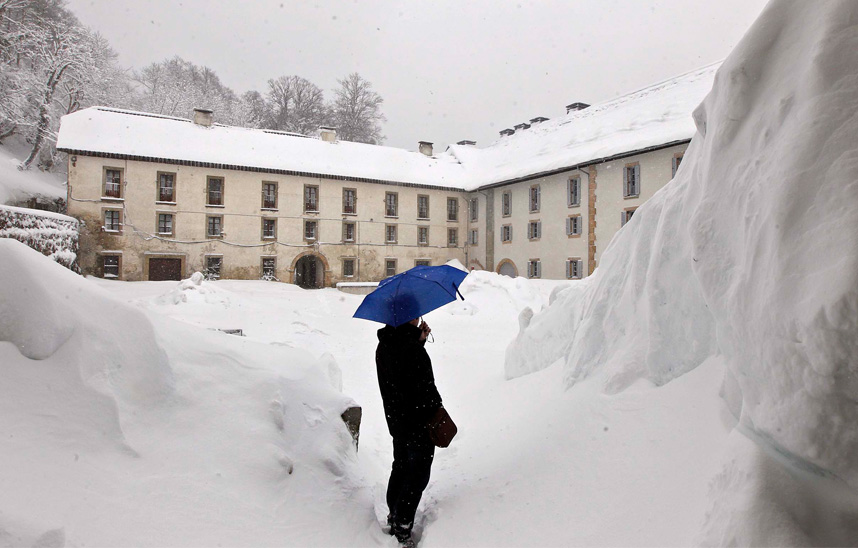Winter rigors in Roncesvalles: the transfer of the collegiate church was considered.

PhotoJ. A. Goñi. Diario de Navarra/Nevada at the collegiate church
A popular proverb collected at the beginning of the sixteenth century stated: "Roncesvalles has eight months of winter and four months of hell", in allusion to the severity of the climate. The written sources also mention the "strong winters and sad summers". The Navarrese doctor, Martín de Azpilicueta, wrote that the sanctuary was "among its deserted summits (of high mountains and crags) covered with gray clouds and white snow, with extreme cold and harsh ice and thick and humid fogs". Several documents give testimony of some historical snowfalls. Among them, it is necessary to mention the one of 1600, manager of the collapse of the old cloister. In that year, 19 palms of snow were measured with a pike in Ibañeta.
Chapels of Sancti Spiritus and Santiago in January 2021. Photo Bibiano Esparza
The winters are described, at the beginning of the XVII century, as "almost intolerable, due to the rigorous inclemency of the region, of cold, ice and excessive snows that usually last until the month of May and some years until San Juan". Regarding the summers, "the calamity of the fogsis mentioned, where they usually spend twenty days and a month without seeing the light of the sun, oozing such strange humidities that force them to be on the fire, when in other parts they burn with heat". The sub-prior Juan de Huarte affirms that life in common was very difficult in those circumstances, and the refectory could only be used in summer, since in the rest of the year it was necessary to eat by the fire, "because there are usually so many snowfalls that, with the houses being almost next to the church, it is not possible to reach entrance, since all the alleys are closed, and the snow goes up to the windows, which in such storms serve as doors for the church, as has happened the present year of 1616, and the biggest work that happens is the one not being able to reach water, because it closes as with wall all the fountains and streams and stagnates the mill and for lack of it the snow melts in boilers and pans for drinking and for the service, the other, the download roofs because with the excess weight would sink the houses, as has happened many times and as it sank the cloister the year of 1600, breaking all its columns and arches, whose repair will cost more than 16.000 ducats".
Not all snowstorms were negative. In November 1613, when the de Baigorry were seeking revenge on the lands of Navarre, so much snow suddenly fell "that it was eight spans in all those mountains, which closed all the entrances, avenues, gates, roads and paths in such a way that it was impossible to enter Alduides or Navarre by the royal and beaten paths and it seemed like a miracle business, because the two previous days the weather was good, warm and clear, and then the following night and the next day, suddenly, the mentioned quantity fell, which was never seen in the mountains of Navarre nor in Roncesvalles, being the burrow of the snow, to settle such a copy and quantity in such a short time". In 1622 and 1623, the snowfalls left the roads impracticable and the canons could not go to church, having to continually download the roofs of their houses so that they would not sink.
General view of the collegiate church in January 2021. Photo Bibiano Esparza
The inclement weather was also reflected in the lightning storms. One of the biggest, referenced in the texts, was that of September 2, 1617, at five o'clock in the afternoon. In the same one it was necessary to lament some personal misfortunes in Burguete, when before the stone and the embarrassment a group of five men, two women -of name Dominica and Inés- and a pair of oxen with the cart of firewood, took refuge under a great beech tree. When they were about to return to the village, a thunder shook Roncesvalles and Burguete and a lightning bolt that is described as "of lively fire that had ignited the buildings, causing terrible fear and fright" discharged in the tree and killed the two women and the oxen.
All these climatic rigors and the frontier location, which did not allow for the quiet and seclusion of a religious community with a regular life, led to the idea of moving the chapter to the interior of Navarre, something that was not done because of the great expenses that the construction of the architectural complex would cause. However, there was also speculation about asking the king for one of the "sumptuous palaces" of Olite or Tafalla, endowed with numerous buildings, arguing that for the monarch they were nothing more than expenses, or moving to San Salvador de Sangüesa. In that case, the hospital would remain in Roncesvalles with a canon and another member of the clergy, with the staff to attend to the institution and a town with natural neighbors with its mayor, all subject to the prior and chapter wherever they were.
